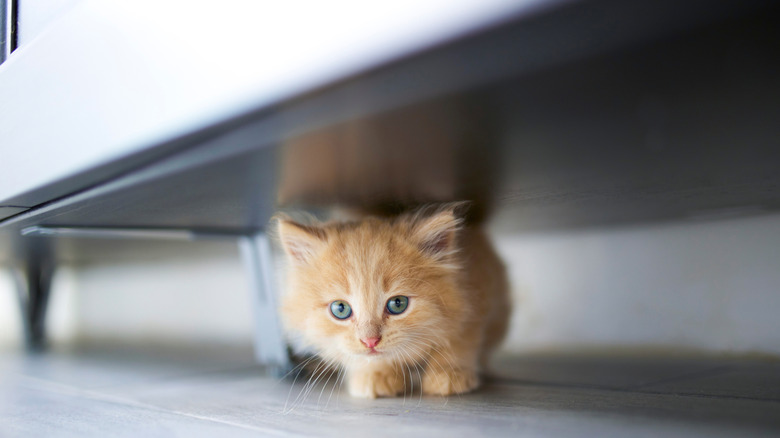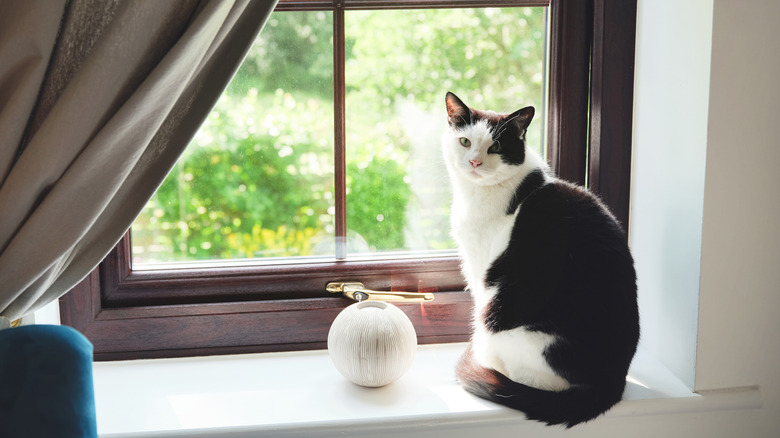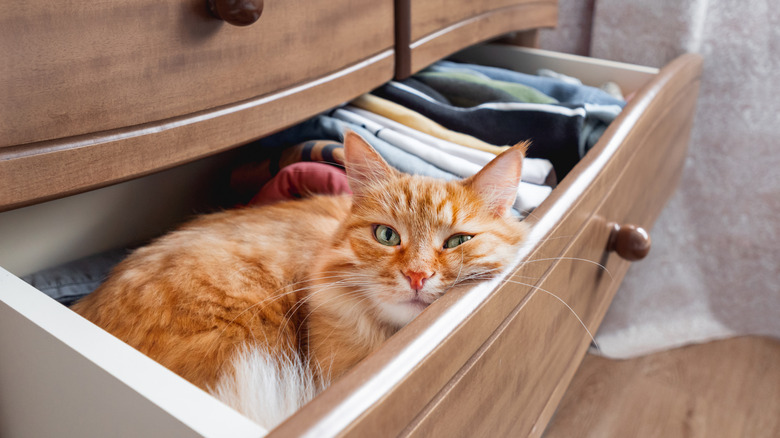Check These Places In Your House Immediately If Your Indoor Cat Goes Missing
They say cats have nine lives, and in some households, cats have many hiding places, too. Cats hide for different reasons, ranging from illness and instincts to safety and security. Regardless of the reason, being unable to find your indoor cat can be worrisome, especially if you recently opened an exterior door and have a curious, adventurous feline. The following list of common household resting spots for cats, which includes places high and low, can shorten your search the next time you're unable to find your furry friend.
You might not know all of your cat's hiding places because they emerge from them when you're not nearby. Or, you might think you know all of them only for your pet to discover a new one. Sometimes, all you have to do is pretend you're a child playing hide-and-seek in your house — or think like a cat — to find your feline if it goes missing. That includes considering these places — and a few might surprise you.
Cats might hide in a closet or other small space with a door
Closets, cabinets, and kitchen pantries don't typically offer any living space for a human, but for a cat, they're incredibly alluring. Oftentimes, cats prefer to sleep in a warm, quiet, and private area — all of which you can find in a closet, kitchen pantry, or similar small space. Of course, the aroma of food gives pets another reason to hang out in a pantry, and those linens convert closet shelves into cozy beds for them.
Think of how many times a day you open the doors of these areas, how often you've found the door cracked or wide open, or how often you've closed it completely after realizing it's been open for hours. In all of these scenarios, your cat has plenty of time to sneak in through the open door without your knowledge. After all, it only takes a second. It can then stay in that room for hours, whether intentionally or not.
To prevent accidentally trapping your cat in a bedroom or hallway closet, kitchen or bathroom cabinet, or food pantry, always check the floor and shelves before closing the door to ensure they're cat-free. If you realize you're unsure of its whereabouts at any time of day, check behind every door, large and small, before putting together a search party.
Your cat might be behind a window or shower curtain
Many cats love looking out of windows and perching on window sills to watch the birds, squirrels, and other outdoor sights or just to enjoy the warmth of the sun. Add a curtain to those windows, and you have the perfect hiding spot for your cat. If the sill is wide enough, your cat might lie down and take a nap or just hang out there for hours.
There's usually no harm in allowing a cat to perch near a window; just be sure not to open it more than a few inches, even if you have a screen. With enough strength, scratching, and willpower, a cat can tear or push through a window screen. Of course, if your feline friend manages to create an opening large enough for its body to fit through and then goes missing, you'll have to expand your search to outside. Otherwise, you'll hopefully find Mr. or Ms. Kitty snoring away behind the curtain.
The privacy offered by a window curtain might not be the factor that allures your cat. A shower curtain, on the other hand, may be more likely to get a cat's attention, even with nothing exciting on the other side. Why? Well, you might find your cat between the shower curtain and liner because it thinks those layers are fun to play with or just hiding in the bathtub, as if waiting to be found.
Cats hide under or inside furniture, too
Have you ever asked yourself, "Why does my cat hide under the bed"? Remember, if you think back to your childhood hide-and-seek days, stowing away under a bed was probably a popular hiding spot for you, too. Or perhaps your four-legged friend's favorite napping spot or place to explore is under the sofa, as that's where spiders tend to hide. Dresser drawers are also a popular choice.
Sometimes, cats find their way inside hide-a-bed sofas as well. A Colorado family knows this from personal experience after they moved from Washington. According to KKTV 11 News, their cat, Sunny-Loo, somehow survived being trapped in their hide-a-bed sofa. Unaware that she was inside, the movers wrapped the sofa and placed it in the moving truck, where it sat for three weeks in transit.
The veterinarian who treated her calls her "a miracle cat." Sunny-Loo survived and fully recovered from the ordeal. Her story serves as a reminder to every cat owner to check not only under furniture but also in it. Remove all of the cushions during your search, check for any holes or openings large enough for a cat, and carefully open any folding furniture items, like sleeper sofas.
Perhaps your cat is on something near the ceiling
Even if a cat never lives or spends any time outside, they instinctively desire to climb or jump up on whatever they can indoors to get a higher vantage point. Sometimes it's to a height that's only a few feet off of the floor, like on the highest part of a sofa or the kitchen counter. Other times, they jump onto something above their humans' eye level and can appear hidden, especially for a short human.
These spots, such as the top of a refrigerator or a tall bookcase, are typically much closer to the ceiling than they are to the floor. If you have a cat tower that stands taller than you, your cat could easily snuggle up in a ball on the top layer and be completely invisible to you from a certain distance.
You may not have found your cat on top of your refrigerator or bookcase in the past, but that doesn't mean you never will. So, if your indoor cat ever goes missing, search in both the expected and unexpected places, and don't forget to look up to those places near the ceiling.




